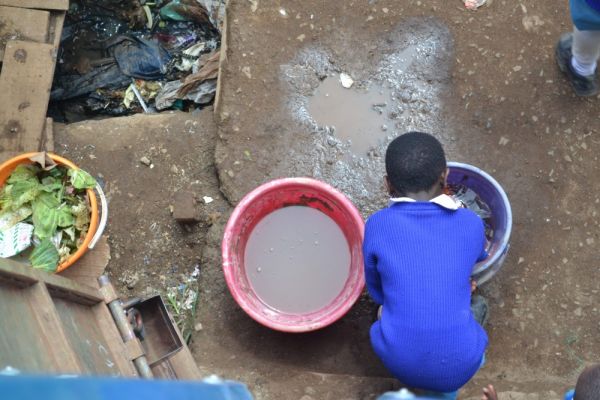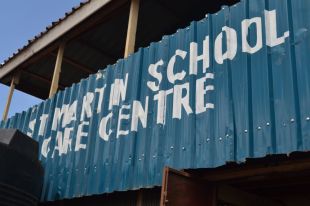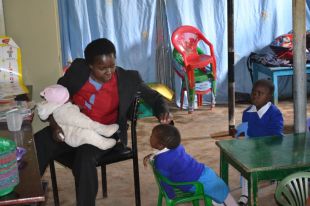Lacking Schools, an Army of Women Teach Kibera’s Youngest

A student draws water outside St. Martin’s school in Kibera. Photo credit: Sam Sturgis
For Jennifer Kerubo, mornings begin at 5 a.m., well before the first rays of sunlight have glinted off Kibera’s sea of corrugated metal roofs. After the single mother has gotten her two children and her nephew ready to start their day, she winds her way down the enormous settlement’s narrow, cluttered alleyways in the dark. By 6 a.m., just as the sky is starting to brighten, Kerubo arrives at St. Martin’s to open the primary school that 250 of this neighborhood’s children rely on for their early education.
In Kibera, a two-square-mile informal settlement in Nairobi where half the residents are under 15, educational opportunities are hard to come by. It’s the city’s most densely populated area, a campaign hot spot for politicians and presidential aspirants, yet the schools and students within it remain largely unrecognized and unsupported by the Kenyan government. Faced with this vacuum of formal schooling, it is local women, often armed with no more than a primary-school education themselves, who teach Kibera’s next generation with an indefatigable sense of mission.

St. Martin’s was opened in 2008 by women in the community. Photo credit: Cosmas Kavinda
“The government mostly doesn’t know of our existence,” says Cecilia Ayot, who, along with Kerubo, helped establish the informal St. Martin’s school in 2008. In addition to an early education, St. Martin’s students, who range in age from three to 12, enjoy aspects of childhood that are often absent from their homes, including hot food and reading materials. And at two stories with a fresh coat of blue paint, the school provides the neighborhood with something, too: a thriving institution with a sense of permanency and careful upkeep. While Mrs. Ayot admits that the primary education offered at St. Martin’s will likely be the only schooling many of these children ever receive, that only makes her and the other volunteer teachers more determined to educate Kibera’s kids, even as they struggle to support their own.
Striking that balance is a daily challenge for Lucy Migai, whose class — appropriately named “baby class” — is engulfed by over forty three-, four- and five-year-olds. Migai writes on the chalkboard with one hand while she gently cradles her three-and-a-half-month-old baby in her other arm. Amazingly, both her class and her child remain silent throughout the lesson.
“At the end of the day, we don’t have resources,” says Migai, who takes care of three kids and two stepchildren of her own, plus an epileptic sister. “You go home and we don’t have money.” The lack of resources is all the more glaring for that fact that, as reported by USAID, the Kenyan government has made primary education a national priority; the sector, at times, has consumed around 30 percent of the national budget. This commitment was reinforced in 2003 when primary schools throughout the country were made free for the first time in history. Since then, Kenya has added 7,000 new public schools and seen a 46 percent increase in enrollment. Due to Kibera’s informal status, however, the settlement’s youth populations and teachers remain largely excluded from the expanding education opportunities that are felt in other Nairobi neighborhoods.

Many of Kibera’s teachers must balance the unpaid job with the need to support their own families. Photo credit: Sam Sturgis
Nevertheless, Kenya’s informal education system has produced results. A 2009 Oxfam report found that about 75 percent of Nairobi’s slum residents have received a primary education, mostly due to innovative efforts by schools like St Martin’s. (Kibera has only about half a dozen formal schools — not nearly enough to serve its whole population, the exact size of which is unknown). That’s a higher percentage than residents of rural Kenya, where public education is free. Moreover, as chronicled in Nairobi’s own Daily Nation, studies have shown that Kenyan primary schools have performed significantly better when parents are actively involved in the school’s operations, as they are at St. Martin’s.
“A number of students come from families that don’t have strong structures,” says one St. Martin’s administrator, noting that the school provides the students with what is likely their only meal of the day, “just to keep them running,” as she puts it.
The herculean efforts of its teachers and staff suggest that if Kibera’s informal education system is stagnating, it’s not due to a lack of ambition. Indeed, Kibera’s schools strive to be at least as successful as government-backed ones. Smiling students are sharply dressed in white-collar shirts and royal blue sweaters, similar to the uniform worn by students in formal public schools. A class curriculum can be found near each of St. Martin’s volunteer teachers, tailored to reflect those issued by the Ministry of Education. These standards are a way to keep Kibera’s children competitive if they’re ever able to access a formal education, the teachers say. The school’s tuition records, however, are filled with blank spaces. One month saw only 12 of 34 students in one of the older classes pay their tuition fees. That trickle of money goes to the school itself, not teacher salaries.
That’s why at 5 p.m., after her students have practiced their English, worked on addition and subtraction exercises, and received a hot lunch and a cup of milk, Jennifer Kerubo will lock up St. Martin’s and begin her other workday — on a street corner selling tomatoes. She hopes to have sold enough by 7 p.m. that she’ll be able to feed her family.
Sam Sturgis has been living in Nairobi since August 2012 while completing his degree in International Studies, focusing on both Urban Development and Africa. Follow him on Twitter @SamPSturgis









